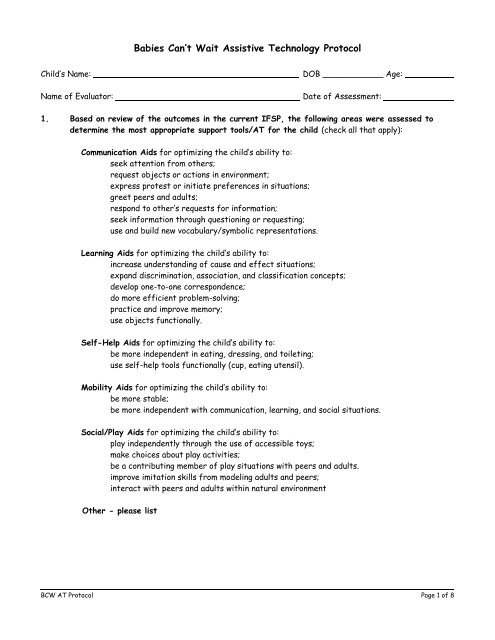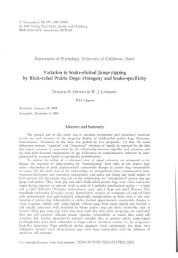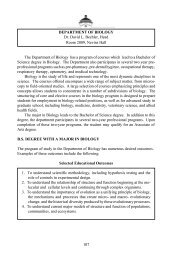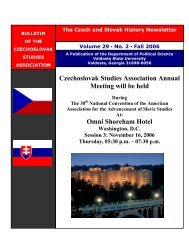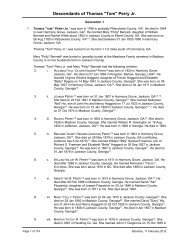You also want an ePaper? Increase the reach of your titles
YUMPU automatically turns print PDFs into web optimized ePapers that Google loves.
Babies Can’t Wait Assistive Technology Protocol<br />
Child’s Name: DOB ____________ Age:<br />
Name of Evaluator: Date of Assessment:<br />
1. Based on review of the outcomes in the current IFSP, the following areas were assessed to<br />
determine the most appropriate support tools/AT for the child (check all that apply):<br />
� Communication Aids for optimizing the child’s ability to:<br />
� seek attention from others;<br />
� request objects or actions in environment;<br />
� express protest or initiate preferences in situations;<br />
� greet peers and adults;<br />
� respond to other’s requests for in<strong>form</strong>ation;<br />
� seek in<strong>form</strong>ation through questioning or requesting;<br />
� use and build new vocabulary/symbolic representations.<br />
� Learning Aids for optimizing the child’s ability to:<br />
� increase understanding of cause and effect situations;<br />
� expand discrimination, association, and classification concepts;<br />
� develop one-to-one correspondence;<br />
� do more efficient problem-solving;<br />
� practice and improve memory;<br />
� use objects functionally.<br />
� Self-Help Aids for optimizing the child’s ability to:<br />
� be more independent in eating, dressing, and toileting;<br />
� use self-help tools functionally (cup, eating utensil).<br />
� Mobility Aids for optimizing the child’s ability to:<br />
� be more stable;<br />
� be more independent with communication, learning, and social situations.<br />
� Social/Play Aids for optimizing the child’s ability to:<br />
� play independently through the use of accessible toys;<br />
� make choices about play activities;<br />
� be a contributing member of play situations with peers and adults.<br />
� improve imitation skills from modeling adults and peers;<br />
� interact with peers and adults within natural environment<br />
� Other - please list<br />
BCW AT Protocol Page 1 of 8
2. Check the behaviors below that may impact the successful use of support tools/AT by the child:<br />
Attention Span:<br />
Length of activities using support tools/AT need to be approximately ________ minutes<br />
The child prefers support tools/AT that is paired with<br />
� visual prompts<br />
� auditory prompts<br />
� vibratory/textured prompts<br />
� action<br />
Child’s Focus:<br />
Child requires the following prompting or reinforcement to maintain focus on task.<br />
� verbal prompts (specify):<br />
� physical prompts (specify):<br />
� other (specify):<br />
Distractibility:<br />
� The child is distracted by other: � visual � auditory activities in the room.<br />
� The child can be easily redirected? � yes � no<br />
Motivation:<br />
� Child is persistent.<br />
� Child reacts to emotions of others.<br />
� Child responds to adult approval.<br />
� Child attempts to self correct.<br />
Humor:<br />
� Child responds differently to different people.<br />
� Child smiles/laughs at absurd, silly names/games (e.g., mis-naming of a sibling, animal).<br />
3. Switch Access Systems:<br />
� Child needs to use switches as an accommodation tool to be successful within his/her natural<br />
environment.<br />
� N/A (go to #4)<br />
Features needed for successful use---check all that apply:<br />
Type<br />
� large switch surface � pull � 1/8" plug (miniature)<br />
� small switch surface � squeeze � 1/4" plug (standard)<br />
� on/off � light touch � 1/16" plug (sub-miniature)<br />
� momentary � timed � other type switch<br />
Feedback<br />
� switch that lights when activated � switch that vibrates when activated<br />
� switch that make a noise when activated � other<br />
BCW AT Protocol Page 2 of 8
Mounting/Stabilization Needs<br />
� switch needs to upright/vertical � secured to table surface so it will not move<br />
� clamping system for wheelchair/table � other<br />
Interfaces<br />
� timer module � other device to activate switch (stick, block, etc.)<br />
� latching module<br />
Placement of switch<br />
� child’s right hand � child’s head � other<br />
� child’s left hand � child’s feet<br />
Needs:<br />
� child needs similar switches in all natural environment settings<br />
� child needs a selected switch to travel across settings<br />
� child needs switch cords to be out of reach<br />
� child needs to understand that a switch turns on things<br />
� child needs to be more consistent with hitting switch<br />
� child needs practice repeating switch hits<br />
� child needs practice hitting switch on cue<br />
� child needs practice using switch to scan choices (better anticipation of hit)<br />
� other:<br />
Comments:<br />
4. AAC Access Systems:<br />
� Child needs to use an AAC device as a support tool to be successful within his/her natural<br />
environment.<br />
� N/A (go to #5)<br />
Features needed for successful use---check all that apply:<br />
Messages or number of choices:<br />
� single message or choice � 5-12 messages or choice<br />
� 2-4 messages or choice � 13 and higher messages or choices<br />
Type of Display/Choices<br />
� real objects � line drawings/picture symbols � auditory scan<br />
BCW AT Protocol Page 3 of 8
� photos � textured surfaces<br />
Output of Device<br />
� recorded/programmed speech � light<br />
� programmable picture display � sound<br />
Child Selection Method<br />
� finger/hand pointing � light pointing � switch selection<br />
� eye gaze � auditory scanning<br />
� light scanning � pointer scanning<br />
Needs<br />
� child needs training on understanding relationship between selecting symbol message and effect<br />
� child needs training to understand choice making<br />
� child needs training on stopping at selected targets during scanning<br />
� child needs training on initiating use of communication device<br />
� child needs training on navigating message/symbol choices<br />
� child needs AAC users as models in natural environment<br />
� words/phrases need to be identified to be used with system<br />
� strategies and activities need to be identified for practice opportunities to use AAC<br />
� Other:<br />
Comments:<br />
5. Environmental Control/Daily Living Systems:<br />
� Child needs to use environmental control systems as an accommodation tool to be successful<br />
within his/her natural environment.<br />
� N/A (go to #6)<br />
Features needed for successful use: Check all that apply:<br />
Types of Environmental Control<br />
� switch interface for electrical appliances (stereo, TV, blender, fan, lamp)<br />
� switch inferface for battery appliances (toys, radios, tape recorders)<br />
� attention-getting signal device (buzzer, bell, single message AAC)<br />
Table Activity Needs<br />
� non-slip/grip surface (rug grip, velcro, clamps)<br />
� built-up utensils (crayons, eating tools, toy handles)<br />
� raised edges/fence to contain items<br />
BCW AT Protocol Page 4 of 8
� adjustable slant table<br />
� backlight for viewing items<br />
� tethering system for keeping items within reach<br />
� adjustable benches for floor activities<br />
� mounting system for dangling items or placing in space<br />
� stiff-page books with page separators (page fluffers)<br />
Self-Help Needs<br />
� velcro for easier taking off<br />
� attention-getting signal device (buzzer, bell, single message AAC)<br />
� built-up utensils<br />
� non-slip/grip surface<br />
Other Needs<br />
� adjustable lighting in natural settings<br />
� portable, stable seating systems (please refer to PT or OT for specifics)<br />
� textured surfaces on items<br />
� child needs training to operate appliances appropriately<br />
Comments:<br />
6. Computer Aids and Software Systems:<br />
� Child needs to use a computer learning systems as an accommodation tool to be successful<br />
within his/her natural environment.<br />
� N/A (go to #7)<br />
� Child currently has in his/her home: � windows computer � macintosh computer<br />
Features needed for successful use: Check all that apply<br />
Input Devices<br />
� child needs an adapted switch trackball to interact with computer software<br />
� child needs a TouchWindow to interact with computer software<br />
� child needs a touch tablet with overlays to interact with computer software (Intellikeys, Muppet<br />
Keys, Key Largo, other )<br />
� child need keyguard to help direct key placement<br />
� child needs larger trackball<br />
� child needs pointer to hit keys, reach TouchWindow, reach touch tablet<br />
Software Utilities<br />
� child needs switch adapted utility software (Click-it) to adapt computer software for switch use.<br />
� child needs a screen enlarger software<br />
BCW AT Protocol Page 5 of 8
� child needs cursor enlarged for sofware use<br />
� child needs software to redefine the keyboard (Ke:nx)<br />
Other<br />
� child needs external speakers to adjust sounds<br />
� child needs textured/color cues for keyboard/TouchWindow selections<br />
� child needs adjustable table for appropriate seating for computer activities<br />
� child needs mounting system for input devices (switch, touch tablet, keyboard, trackball)<br />
� child needs appropriate sofware that can be switch adapted<br />
� child needs real objects to be paired with computer software activities<br />
� child needs to learn mouse behaviors (point and click, dragging, etc.)<br />
Comments:<br />
7. Recommendations<br />
Include a description of strategies/activities that will assist the child’s family and service providers<br />
in using the recommended support tools/AT in the natural environment with the child, as well as<br />
resources that can help:<br />
Strategies/Activities:<br />
1.<br />
Resources/People:<br />
Description of necessary training in order for the child, family, and service providers to appropriately<br />
utilize recommended support tools/AT (how to use the device, repair/maintenance, learning how to<br />
position devices, etc.):<br />
BCW AT Protocol Page 6 of 8
Purchase/Lease<br />
Comments:<br />
Name of Product:<br />
Manufacturer:<br />
Customization Needed:<br />
Approximate Cost (If device needs to be purchased):<br />
Source: � BCW Lending Library � Vendor Loan � Provider Loan �<br />
Purchase/Lease<br />
Comments:<br />
Name of Product:<br />
Manufacturer:<br />
Customization Needed:<br />
Approximate Cost (If device needs to be purchased):<br />
Source: � BCW Lending Library � Vendor Loan � Provider Loan �<br />
Purchase/Lease<br />
Comments:<br />
Name of Product:<br />
Manufacturer:<br />
Customization Needed:<br />
Approximate Cost (If device needs to be purchased):<br />
Source: � BCW Lending Library � Vendor Loan � Provider Loan �<br />
Purchase/Lease<br />
Comments:<br />
Evaluator Signature Date<br />
BCW AT Protocol Page 8 of 8


